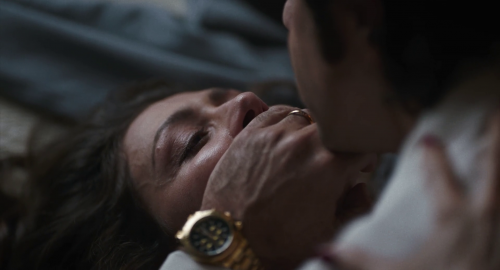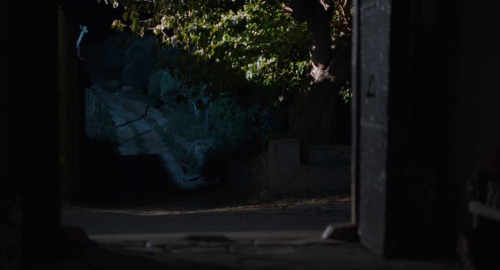‘The Traitor’, A Correspondence
The Game of Simulations
Click aquí para la versión en español
Introduction
The mechanism is as follows: two authors exchange letters via email, for two weeks, on The Traitor (Il traditore, Marco Bellocchio, 2019); their correspondence is published here according to rules established at the outset. The game is quite simple: the opening participant proposes a title, a screenshot and a short text, which results in a response from the other author who, in turn, proposes a second title, a second screenshot and a second short text addressed to the first participant. The exchange continues with several more moves by both authors, Adrian Martin (AM) and Carles Matamoros (CM), who aim to share and convey their passion for the latest film of this great Italian director.
1. The Numbers (AM)
The portrait of a criminal family, a criminal network: 30 people in one frame, over-illuminated and then plunged into eerie, funereal darkness by a flash bulb. Over and over: people frozen, identified (their names printed on the screen), numbered as a collateral corpse at the moment of their death. The complex opening sequence of Marco Bellocchio’s The Traitor lays out some of the film’s central motifs: an unstoppable seriality (in an image and across time) that absorbs and destroys everyone; the frozen pose that, in his cinema, always signifies death in contradistinction to the life-giving moment of joyous, Dionysiac dance. With a crucial difference, here: whenever Tommaso Buscetta (Pierfrancesco Favino) moves (from room to room, house to house, nation to nation), it is not in a sweep of pleasure, but a restless, neurotic, haunted deferment of the preordained, gridded pattern of his brutal Mafia life. The central question of the story: can Tommaso ever escape that grid – and how?
1b. The Hands (CM)
The hands of Pippo Calò (Fabrizio Ferracane) on Tommaso’s back in the family photograph: they already foreshadow the unbearable burden that Bellocchio’s tragic hero will carry after his Brazilian exile. Tommaso will never be able to escape from this initial imprint because their bond will be sealed with an affectionate hug under the fireworks of Santa Rosalia: Tommaso entrusts Pippo with the life of his two eldest children, Benedetto Buscetta (Gabriele Cicirello) and Antonio Buscetta (Paride Cicirello), also located in a central spot in the composition. But who then will be the traitor in this story? The father (Tommaso) who abandons his offspring in Italy and then betrays those who annihilate his colleagues and family to justice? Or the apparent friend (Pippo), who murders Benedetto literally with his own hands?
2. The Screens (CM)
Bellocchio’s rectangular frame is reformulated in a panoptic form in the video surveillance room belonging to the prison where the Mafia members betrayed by Tommaso are locked in. Multiple screens that individualise singular personalities and, at the same time, in the same frame, in a single image of images, gather various members of the earlier criminal family portrait. Pippo, of course, is again located in the centre and we have two perspectives: the close-up of his face (above) and the overhead shot of his cell (below). Among the different screens that transmit live what is going on inside the prison, three stand out: they are broadcasting an external event, the State funeral of Giovanni Falcone (Fausto Russo Alesi), the key lawyer in the State’s Maxi Trial brought against the Cosa Nostra. This media event is closely linked to the criminals trapped in the same shot, thus exemplifying two of the dialectical resources with which The Traitor works: the occasional integration of archival images that punctuate the fictional events; and the proliferation of scenes in which the characters follow on TV the news that impact their lives (there are even TV sets in the cells of the imprisoned Mafiosi!). The fabrication of a political tale in Italy as elaborated by the mass media – in response to which Bellocchio offers, in several of his historical films, alternative re-presentations of famous people – is more evident in the following shot of another control room: the television studio were Tommaso is interviewed.
2b. The Dreams (AM)
The dreams that punctuate the film – an essential element of Bellocchio’s method since the mid 1980s – are a crucial variation on the surveillance and media screens. As externalised images, dream-visions of various sorts (memories, reveries, hallucinations), they belong to the realm of the imaginary, and this imaginary is always collective and social, never merely individual. Even the openly metaphorical, Eisensteinian inserts of a tiger (prowling inside its cage) and of rats («deserting a sinking ship», as the saying goes) have an oneiric force. Trying to sleep on the plane, Tommaso sees his now dead sons spectrally passing along the aisle and out through the back curtain: a banal invisibility that, nonetheless, sparks a Shakespearean level of guilt in him. Later, an even more terrifying apparition worthy of a giallo – as Tommaso lies down in his relatively comfortable and secure but still soulless holding pen – shows his entire family crowding around his open coffin, as if pressing him into the circle of death with which he is so deeply associated. Tommaso, as we are told in the final, written-on-screen detail, died in bed in April 2000, in his sleep, as he always wanted. But how could this sleep ever be peaceful? In Bellocchio, sleep is forever haunted by the ghosts of personal and political, moral and ethical accountability.
3. The Causes and The Effects (AM)
The Traitor is a tightly organised and hyper-structured film, like the corrupt network it depicts: each moment, each incident or detail in it has an immediate correspondence or repercussion and then, further away in time and space, a wider resonance. As a deliberately hollowed-out version of a classic gangster film, it invests the most basic plot mechanics of the genre with an eerie fatalism. This process is also fundamentally cinematic, since what is at stake in the life of a gangster – and even more so, a traitor – is literally sound and image: making a noise, and/or being seen, are what will get you killed in an instant; nobody who goes public, who steps out of the silent shadows as Falcone does, will last long. The entire film, in both its form and content, is built on this dynamic principle of image and sound. Image: Tommaso, in the courtroom, is always attempting (without much success) to shield his eyes, covering his vision in dark glasses, averting his gaze from those who want to kill him, walling his whole body in glass protection. Sound: when Tommaso makes love to his wife, Cristina (Maria Fernanda Cândido), he places a hand over her mouth to stifle her cries of pleasure, and instructs her to be quiet. Soon, we will see a different Cosa Nostra couple murdered (as if in a dream-displacement) naked in their beds, during sex. Even a family’s most innocent outbursts – like cheering while watching a soccer match on TV – seem to immediately bring an answering tone of doom: the mysterious phone call addressed to Tommaso. For sounds not only betray presence, but also announce menace: the Sicilian folk song that sends the Buscetta family fleeing a New Hampshire restaurant is verified, six years later in Palermo, enigmatically and sinisterly, by Pippo singing it to Tommaso in court.
3b. The Gesture (CM)
The gesture of Tommaso to Cristina not only demonstrates the film’s unstoppable sonic tension, but also the possessive character of its protagonist. We know he is able to make his enemies submit – but that is also true of his women, whether lovers, prostitutes or wives. When he is arrested at his home in Brazil, Tommaso vehemently orders Cristina to shut up in front of the police. When he remembers the past in the company of his Sicilian friend Totuccio Contorno (Luigi Lo Cascio), he evokes a time when voluptuous women fell into their arms – even while he was imprisoned. The character’s memory of that conqueror phase in an idealised Cosa Nostra emerges on screen in an eloquent flashback, which represents the abysmal jump between the present (in which Tommaso dyes his hair coquettishly before a mirror to camouflage his ageing) and the past (a prison in Palermo where the inmates must leave the shared dormitory so that Tommaso can be intimate with a young woman at his service). However, this flashback quickly adopts a sick, morbid tone – as if the character cannot escape these ghosts that haunt him, even when he recalls his happy days. In the conjured scene, Tommaso observes that one of the elderly prisoners remains in the cell, so he approaches the man’s bed and discovers that he has died in his sleep. Discreetly, Tommaso covers the inmate’s inert body with the sheet, before returning to his bed where he fucks the prostitute he has previously invited to undress. Eros and Thanatos are inseparable in his memory.
4. The Karaoke (CM)
The disquieting Sicilian melody sung by both the musician in an American restaurant and by Pippo is not the only song we hear twice in The Traitor: the emblematic bolero “Historia de un amor” (“Story of a Love”) appears in two mirroring scenes that are in dialogue with each other. First, in the celebration staged by Bellocchio of the 68th birthday of Tommaso who, in front of family and friends, sings it precariously and emotionally, in a state of drunkenness. Then, in the sequence before the final credits, where murky archival video footage of that same birthday party is revived, with the real Buscetta suddenly on stage. If we focus on the first of these musical performances, we can see how Bellocchio works with one of the most stimulating (audio)visual motifs of contemporary cinema: karaoke scenes. The Traitor’s scene does not take place strictly in a bar of this type: the melody is not completely pre-recorded (there’s a keyboardist playing live) and there’s no monitor on which the song lyrics scroll. All the same, we are absorbing a privileged moment, comparable in its form to those that emerge in works as diverse as Lost in Translation (Sofia Coppola, 2003), Only God Forgives (Nicolas Winding Refn, 2013), HHH – A Portrait of Hou Hsiao-Hsien (Olivier Assayas, 1999), My Best Friend’s Wedding (P.J. Hogan, 1997), Oasis (Lee Chang-dong, 2002), or the final episode of the fourth season of Better Call Saul (Vince Gilligan and Peter Gould, 2015- ).
It is well known that karaoke scenes can lead to moments of plot inflection, where characters free themselves from their fears, show us their weaknesses, transform themselves into different people, and even bring us near the level of the transcendental. In the case of Favino’s interpretation, there is a noticeable evolution that Bellocchio demonstrates in a series of shots capturing the reactions of the spectators: as the performance progresses, we pass from initial cheerful smiles to solemn expressions. The melancholic tale of this bolero – which Carlos Eleta Almarán composed in the 1950s following the death of his brother’s wife – plus the changing expression in Favino’s perspiring face, with a contained emotion revealed in his saddened eyes, ends up giving the scene an unmistakeable bitterness. This bitterness can be attributed to the character’s lament over the passing of time, but also to the insurmountable remoteness of his native Italy, and a life overshadowed by the weight of death. It is not surprising that, in this same party, Tommaso eventually confesses that he is seriously ill, while watching from the distance the guests’ cheerful “musical chairs” game in which he can no longer participate. The final video images give a surplus value to the scene, since they allow us to determine the similarities and differences between Bellocchio’s Buscetta and the real Buscetta on the basis of their singing performances. After all, karaoke is the art of simulation, and this game of appearances finally defines what The Traitor is fundamentally addressing – since Pierfrancesco Favino simulates a historical character still very present in the imaginary of his country; and, in turn, the Italian director pursues the elusive identity of a Tommaso who is variously gangster, hero, traitor, exile and puppet of the State. Thus, an inscrutable lifetime of simulations, set to the rhythm of a bolero.
4b. The Cigarettes (AM)
The cigarettes form another important motif in the film, another pattern of comparisons bridging many levels. During the trial, Bellocchio places a quote from Michel Butor into the mouth of an erudite mafioso behind bars: “The gaze is the expression of reality”. Butor’s theory is, in fact, very close to Bellocchio’s method as a filmmaker; as the writer said: “We never look at a face twice in the same way … we question it differently”. So it goes with the cigarettes. The intimate (and somewhat aggressive) ritual of a shared puff is established early, when Tommaso, on their verandah in Brazil, takes Cristina’s cigarette. Between Tommaso and Falcone, it is a major dealbreaker in establishing their rapport: Tommaso tells Falcone later that he would never have accepted a smoke from him if the pack had not already been open … Cigarettes (like bicycles) sometimes function in the film to make strange certain events and situations: the mafiosi imprisoned in their cages during the trial smoke furiously (cigars or cigarettes, it becomes a legal tussle!). In one of the most striking historical footnotes presented, it is argued that importing heroin spelt the end of the old Cosa Nostra; if they had stuck with cigarettes, it all would have stayed fine! And a cigarette, lovingly smoked and discarded, also figures in the final move made by both the film, and by myself in this writing-game of simulations …
5. The End (AM)
Film narratives depend on spectators both remembering and forgetting things. We remember in order to identify (plots, faces, names, important information), to keep track of the unfolding story. We forget in order that we might, with a jolt of surprise or delight, rediscover a detail in all its ultimately revealed significance. Naturally, this game of simultaneously showing and concealing things (through underplaying or understatement), so that they can eventually be uncovered, is a measure of a filmmaker’s storytelling skill: it is an art of willful misdirection. In a stunning game inside The Traitor, this misdirection comes in the form of a bold sleight-of-hand, a true magician’s trick worthy of Orson Welles. At 50 minutes into the film, Tommaso begins, with theatrical deliberation, to tell a story that Bellocchio visualises in flashback. It is the story of how Tommaso, as a young man, was given a designated hit: however, this other man, sensing his fate, clutched his newly baptised baby to his chest, knowing this would avert the assassin’s bullet. Then – jumping through the years – Tommaso tells us how this target never left home without his son by his side. “Then the son got married” … but, right there, Tommaso digresses in order to amplify a general point to his interlocutor, Falcone: in those days, the Cosa Nostra code meant no killing of children, women or judges. Falcone begins arguing with him about this assumption of morality and ethics. And the film pursues this point, instantly going in a new direction.
How quickly we forget – taken up in the film’s energetic, mosaic flow – that we have missed the punchline of Tommaso’s story! It was simply pushed aside, just in the way that windy monologues are often interrupted in real life by impatient listeners, never reaching their conclusion. Until – a full 90 minutes of screen-time later! – Bellocchio takes us, via a transitional comparison of two moons in the night sky, to exactly that untold conclusion, now given without a narrating voice – Tommaso may be remembering or dreaming it, but he is no longer in control of it; Bellocchio has well and truly taken the driver’s wheel. A wedding party is ending; the father embraces his son in a fond farewell; a dog lazily sleeps at the entrance of this ample courtyard. In the present – allowing a crucial ellipse in the flashback – Cristina gently removes the rifle from Tommaso’s hand (he, too, now divested of his protection) and covers his sleeping body with a blanket. Back to the past: guests leave in their cars down the road behind the dog; the proud father relaxes, alone, pulls up a chair, gazes up at the moon, smokes and discards a cigarette. Then, as he stands, there is something in his eyes, his bearing, his gaze, that possibly signals that he knows exactly what is coming. Tommaso, as if magically, arrives from the darkness – Bellocchio giving us now an ageless character unconstrained by strict historical chronology, this could be happening in any year – and carries out his initial command. So much about The Traitor’s deepest themes is implied here: the ambiguity of honour, the obedient (almost robotic) carrying out of orders (like another «simple soldier” in The Irishman [Martin Scorsese, 2019]), the question of what changes and what does not change with time … As Tommaso exits, the film holds on this final, archway frame (my chosen screenshot) that recalls the opening verse of Bob Dylan’s “One Too Many Mornings” (1964):
Down the street the dogs are barkin’
And the day is a-gettin’ dark.
As the night comes in a-fallin’
The dogs’ll lose their bark.
An’ the silent night will shatter
From the sounds inside my mind.
Yes, I’m one too many mornings
And a thousand miles behind.
© Adrian Martin & Carles Matamoros, December 2019 / English translation © by Cristina Álvarez López & Adrian Martin, December 2019





